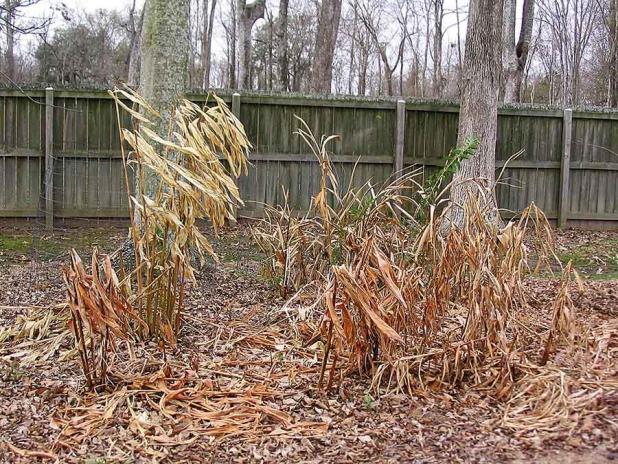
Herbaceous plants, like gingers, can be cut back a few days after a killing freeze. The plants will regrow from the roots if they have not been damaged.
—Dan Gill/LSU AgCenter photo
Horticulturist: Ways to deal with freeze-damaged plants
Last month, Louisiana experienced the coldest winter temperatures we have seen in many years. Temperatures ranged from around 20 in the southernmost parts of the state to teens in the central portions and single digits in north Louisiana. While reliably hardy plants in our landscapes came through this weather without significant damage, tender tropical plants around the state were extensively affected.
Tropical plants, such as palms and gingers, are present in north Louisiana landscapes but are more commonly used in the southern part of the state. In south Louisiana, the damage done to any landscapes extensively planted with tropical has been devastating. At this point, it’s time to assess the effects of the freezes and deal with the damage that has occurred. I’ve gotten lots of questions on this topic in the past few weeks.
Tender plants in containers outside are especially vulnerable to the cold. Ideally, they should be moved indoors or into a garage where they will not be exposed to freezing temperatures. If you took a chance and left container tropicals outside and they have sustained cold damage, learn from this. Make a point of bringing outside container tropicals indoors in the future if you want to prevent damage.
For tropical plants growing in the ground, don’t be overly distressed if those you carefully covered and protected still show freeze damage despite your efforts. Damage always occurs to tender plants that are covered when temperatures reach the low 20s or teens, but they often survive and recover. When temperatures reach the single digits and stay below freezing for extended periods, even protected plants may be killed.
To maximize protection from covers, make sure the cover extends all the way to the ground and is sealed. Multiple layers of cover provide more protection than a single layer. Also, providing heat under the cover is needed when temperatures will reach the low 20s or teens. This is often done by generously wrapping and draping a plant with small, incandescent outdoor Christmas lights under the cover. Continue to cover and protect even the damaged tropicals in your landscapes should we have additional freezes.
The question I get most often from gardeners after major freezes is usually, “Is my plant still alive, and will it recover?” This is a question hard to answer for individual plants. There are way too many variables. But it doesn’t hurt to be optimistic.
The second concern is, “What should I do to help my plants recover?” Unfortunately, the damage is done. Nothing you do now will take that away. If the plants survived, they will recover if you simply leave them alone. If they didn’t make it, nothing you do will bring them back. Do not fertilize now, water excessively or do anything like that.
Generally, about all you want to do is to prune off dead, cold-damaged tissue. This is done mostly to neaten things up. Pruning or not pruning is not a major factor in helping cold-damaged tropical plants survive or recover.
The rule of thumb in pruning back freeze-damaged tropicals is: if you can determine what is alive and what is dead on the plant, feel free to prune off the dead tissue. If you are not sure, you may leave them alone until spring. At that time, when the living parts of the plants begin to sprout and grow, it will be easy to see what is dead and you can prune then.
It is not hard to see what is dead on tender herbaceous plants — such as cannas, ferns, elephant ears, birds-of-paradise, begonias, crinum, agapanthus, amaryllis, impatiens, philodendrons, pentas and gingers — so we generally prune them within a few weeks after a freeze event.
But the woody stems of woody tropical shrubs, trees and vines — such as hibiscus, bougainvillea, tibouchina, angel trumpet, croton, ixora, schefflera, copper plant and rubber tree — do not obviously show cold damage, even though the foliage may be totally dead. A dead woody stem can look much like a living woody stem, although splitting and peeling of the bark are a good sign the stems are dead. So we tend to just leave woody tropicals alone and wait for spring. At that time, we can see where they sprout out and prune accordingly.
However, if you can clearly determine what branches are dead on a woody plant, you can prune them back. Try scratching the bark with your thumbnail. If the tissue underneath is green, it’s still alive. If the tissue is tan or brown, the branch is dead. Start at the top and work your way down to see how far back the plant was killed.
Don’t get discouraged at this point. Although you may see a depressing amount of damage to landscape tropicals, many are still alive and will appreciate continued protection as needed through the rest of winter.
Prune brown, dead fronds from palm trees in spring. Give any palms that lose all of their fronds until July to send up new growth before making the decision to remove them.
Cold-damaged plants that produce bulbs, rhizomes or other fleshy below-ground organs should be fine, including agapanthus, amaryllis, crinum, canna and ginger. Cut badly damaged foliage back down to the ground and apply mulch over the below-ground parts.
After the freezes last month, you may decide to reduce the percentage of tropicals that make up your landscape by planting hardy, evergreen plants. If you decide to do this, you have plenty to choose from. The overwhelming majority of trees, shrubs and ground covers available at area nurseries are fully hardy in Louisiana.
